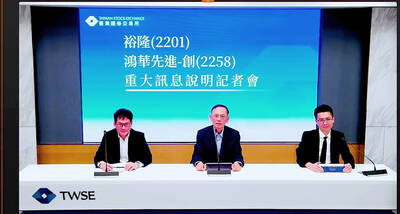Amazon.com Inc is joining Microsoft Corp and Google in the generative artificial intelligence (AI) race, announcing technology aimed at its cloud customers as well as a marketplace for AI tools from other companies.
The e-commerce giant’s Amazon Web Services (AWS) unit on Thursday announced two of its own large-language models, one designed to generate text and another that could help power Web search personalization, among other things.
Amazon announced no plans to release a chatbot like the ones Microsoft and Google have debuted.

Photo: Reuters
Amazon’s large-language models, called Titan, were trained on vast amounts of text to summarize content, write a draft of a blog post or engage in open-ended question-and-answer sessions.
They are to be made available on an AWS service, called Bedrock, where developers can tap into models built by other companies plugging away at generative AI, including AI21 Labs, Anthropic and Stability AI.
In an interview with Bloomberg Television, AWS chief executive officer Adam Selipsky said that customers asked: “‘What can you do to help us with generative AI?’”
While conceding that the technology is at an early stage, he said the company’s in-house chips mean Amazon can provide cost-effective solutions and performance.
Generative AI, software that can create text, images or video based on prompts from a user, has captured the imagination of Silicon Valley, setting off a fierce competition to capitalize on the technology.
Amazon shares rose 4.6 percent to US$102.31 at 3:42pm in New York.
Microsoft, through a partnership with ChatGPT maker OpenAI, has integrated generative AI technology into its Bing Internet search service and plans to deploy those tools across the software maker’s products.
Alphabet Inc’s Google is racing to make similar moves.
Meta Platforms Inc has released its own large-language model and said similar work would expand across the company.
AWS, which sells on-demand computing power and software tools — including a suite of machine-learning applications — had previously partnered with AI companies including Hugging Face Inc and Stability AI, which builds the image generator Stable Diffusion.
However, AWS had not previously revealed plans to release a homegrown large-language model.
AWS vice president of databases, machine learning and analytics Swami Sivasubramanian said that Amazon had long been working on large-language models.
They are already used to help shoppers find products on Amazon’s retail Web site and to power elements of the Alexa voice assistant, among other applications.
“Amazon has been investing in this space for quite a while,” Sivasubramanian said in an interview.
Sivasubramanian said that the company had not settled on pricing to access the tools, but said that homegrown chips built by AWS, including Inferentia2 and Trainium, could help customers keep costs low as they do their own machine-learning work.
The Seattle-based company on Thursday also said that CodeWhisperer, which uses predictive tools to proactively suggest code as developers type it, would be free for individual developers.
“I don’t believe there is going to be one model that will rule the world,” Sivasubramanian said.

Taiwan Semiconductor Manufacturing Co (TSMC, 台積電) last week recorded an increase in the number of shareholders to the highest in almost eight months, despite its share price falling 3.38 percent from the previous week, Taiwan Stock Exchange data released on Saturday showed. As of Friday, TSMC had 1.88 million shareholders, the most since the week of April 25 and an increase of 31,870 from the previous week, the data showed. The number of shareholders jumped despite a drop of NT$50 (US$1.59), or 3.38 percent, in TSMC’s share price from a week earlier to NT$1,430, as investors took profits from their earlier gains

In a high-security Shenzhen laboratory, Chinese scientists have built what Washington has spent years trying to prevent: a prototype of a machine capable of producing the cutting-edge semiconductor chips that power artificial intelligence (AI), smartphones and weapons central to Western military dominance, Reuters has learned. Completed early this year and undergoing testing, the prototype fills nearly an entire factory floor. It was built by a team of former engineers from Dutch semiconductor giant ASML who reverse-engineered the company’s extreme ultraviolet lithography (EUV) machines, according to two people with knowledge of the project. EUV machines sit at the heart of a technological Cold

TAIWAN VALUE CHAIN: Foxtron is to fully own Luxgen following the transaction and it plans to launch a new electric model, the Foxtron Bria, in Taiwan next year Yulon Motor Co (裕隆汽車) yesterday said that its board of directors approved the disposal of its electric vehicle (EV) unit, Luxgen Motor Co (納智捷汽車), to Foxtron Vehicle Technologies Co (鴻華先進) for NT$787.6 million (US$24.98 million). Foxtron, a half-half joint venture between Yulon affiliate Hua-Chuang Automobile Information Technical Center Co (華創車電) and Hon Hai Precision Industry Co (鴻海精密), expects to wrap up the deal in the first quarter of next year. Foxtron would fully own Luxgen following the transaction, including five car distributing companies, outlets and all employees. The deal is subject to the approval of the Fair Trade Commission, Foxtron said. “Foxtron will be

INFLATION CONSIDERATION: The BOJ governor said that it would ‘keep making appropriate decisions’ and would adjust depending on the economy and prices The Bank of Japan (BOJ) yesterday raised its benchmark interest rate to the highest in 30 years and said more increases are in the pipeline if conditions allow, in a sign of growing conviction that it can attain the stable inflation target it has pursued for more than a decade. Bank of Japan Governor Kazuo Ueda’s policy board increased the rate by 0.2 percentage points to 0.75 percent, in a unanimous decision, the bank said in a statement. The central bank cited the rising likelihood of its economic outlook being realized. The rate change was expected by all 50 economists surveyed by Bloomberg. The